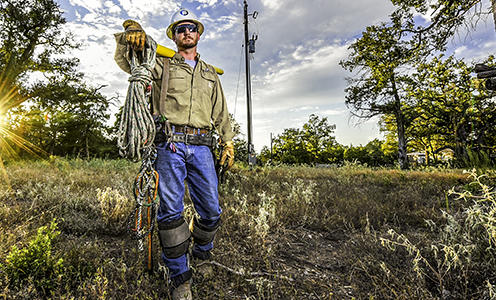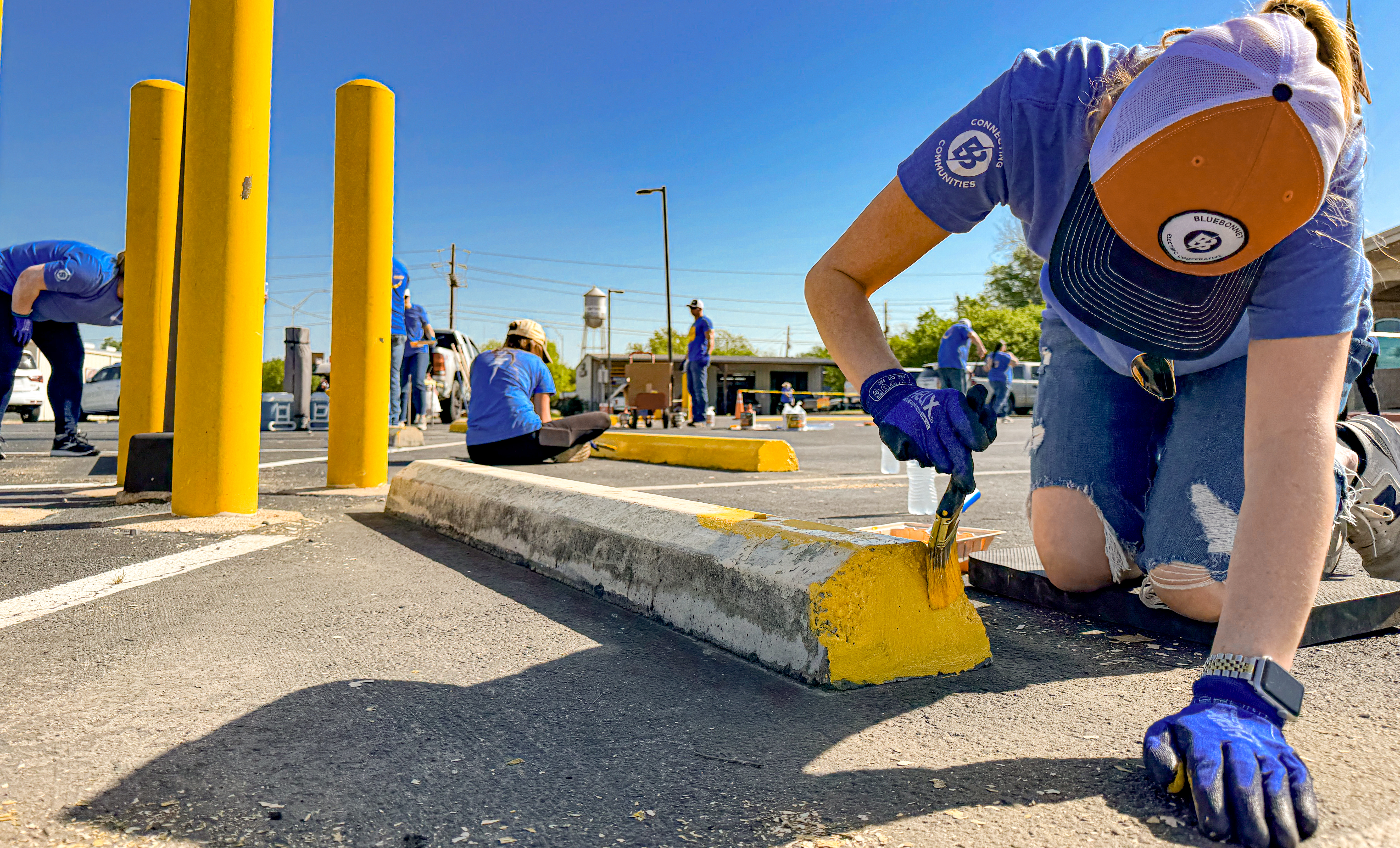The cooperative way
Recent news
Bluebonnet Electric Cooperative offers several ways for members to seek help paying their bill. These self-service options are available 24/7 online, on the MyBluebonnet mobile app and through our automated phone system.
ONLINE
Our website offers information about payment extensions, local energy assistance providers and other helpful information such as a weatherization program that covers home improvements to reduce your power bill.
When you request a payment extension, you will be directed to log in to your MyBluebonnet account. If you haven’t yet registered for a MyBluebonnet account, on the login screen click “Sign up to access our Self Service site.” You can also click Register at the top of bluebonnet.coop. Once you’ve logged in, click on the Billing & Payments tab, then the Payment Extensions link.
This option gives qualified members an extension on the due date of their current monthly bill. The member must be past due only on their current bill, have applied within 10 days of the due date and have met the requirements of previous payment extensions.
If you are looking at bluebonnet.coop on a mobile device, you will need to log in to your MyBluebonnet account. Click on Billing & Payments, then Payment Extensions.
MOBILE APP
On the MyBluebonnet mobile app, log in and click on the Bill & Pay icon, then Payment Extensions. Click the small ‘I’ in the top right corner of the screen for more information about payment extensions. If you haven’t downloaded the new app, just search MyBluebonnet in Apple’s App Store or Google Play. Members can register for a MyBluebonnet account through the app’s launch screen. Click “Don’t have an account? Register now.”
BY PHONE
The MyBluebonnet automated phone system now offers members the option to request a payment extension. Call 800-842-7708, and once prompted, press 2 to use the automated system, then press 2 to request a payment extension.
Bluebonnet knows that the COVID-19 outbreak continues to financially impact many families and businesses. We do our best to work with members who need help with their electric bill. If these self-service options don’t meet your needs, call a member service representative at 800-842-7708 between 8 a.m. and 5 p.m. Monday through Friday.
By Clayton Stromberger and Denise Gamino
If you were born at least fourscore and seven or so years ago, and grew up in these parts, you may remember what it was like in 1939.
No one was in a huge rush back then. The highway speed limit was 45 mph — lower for trucks. More than half the state was rural. Kids in the country rode a horse to confirmation class. Air conditioning meant opening a window or sitting on the front porch with a hand-held fan from church. Screen time was for when the mosquitoes came back.
To communicate with faraway friends and family, you wrote long letters by hand and carefully saved the letters you received. To make a telephone call, you usually had to go through a switchboard operator — someone like German-born Selma “Grandma” Schwartz in Burton, who’d been on the job 29 years in her big wooden swivel chair and kept all the party lines straight with constant plugging and unplugging of cords and jacks. Folks read the local weekly newspaper page by page, and each issue had a section to keep you updated on the important comings and goings around town (“Miss Martha Woodson, of Texas University, Austin, was home last week-end.” “Eben Price, of Waco, was a business visitor here Tuesday of this week.”)
Somehow everyone survived without Twitter and cell phones.
At the country store, or the town café, people would stand or sit around and talk with neighbors and strangers about the weather or politics or how the Aggies were doing — and they were doing well, working their way to a 20-0 Thanksgiving Day drubbing of the Longhorns and, by season’s end, the national title. On the radio, if you could afford one, you might listen to Jack Benny or Bob Wills or perhaps Fred Waring and his orchestra; everyone would gather around when it was time for one of President Franklin D. Roosevelt’s “fireside chats.”
Kids buying comics at the town drugstore had new favorite characters to follow — Batman premiered in “Detective Comics” in May and “Superman No. 1” appeared in June.
The Great Depression, which had begun with the stock market crash a decade earlier, was slowly beginning to ebb and recede, and folks finally started to have a bit of pocket money. The minimum wage rose a nickel to 30 cents. Yams were two cents a pound at Dippel’s Food Store in Caldwell; a 28-ounce jar of Pure Apple Butter was 17 cents. When going into town, men wore hats and often a jacket and tie. Women wore hats, too, and dresses — nothing too fancy, and sometimes made at home, but they were part of what was considered proper attire for Main Street in the communities within the Bluebonnet service area. There was a lively bustle on weekdays and often on Saturdays as well. And it was a treat on a Friday night to see a movie at the Strand in Bastrop, the Sterling in Giddings or the Baker in Lockhart (showing the first week of January, 1939: “The Dawn Patrol” with Errol Flynn).
The theaters were segregated, as were the schools, the water fountains and lunch counters. Slavery and the Civil War were still in the living memory of the area’s oldest residents. Lifelong Travis County resident John Crawford, who was 81 in 1939, could still tell a visitor about his early days as a slave on a plantation in Manor. He was a child when word came of the Emancipation Proclamation of 1863, but back in 1939, he had detailed memories of the day more than seven decades earlier.
In 1939, shiny new automobiles enticed passers-by at small downtown dealerships or glided by with their large graceful curves and Art Deco grilles. They made the occasional surviving beat-up Model A look like a raggedy scarecrow in comparison. The new model Chevy pickups were touted in ads as “big, brawny,” with improved “Supremline styling” and front windows you could crank open.
While filling up at Arbuckle Oil in Elgin, you might pull up alongside one of everyone’s favorite vehicles — the Blue Bell Creameries delivery truck, a refrigerated 1933 Chevy model that chugged up and down the country roads to deliver 5-gallon cans of “B.B. Ice Cream” to Lotta Cream counters in drugstores across the area. Lotta Cream booths — created in 1935 by Blue Bell General Manager E.F. Kruse to sell scoops inside local establishments — were your places to go for relief on a broiling summer weekend, all for a nickel a cone. On a typical Saturday in August, customers at the Lotta Cream #1 inside Mr. Schmid’s Savitall grocery store in Brenham consumed 110 gallons.
Life moved at a calm pace, but changes were just around the corner. In parts of Central Texas where the night had long been lit only with moon glow, candles and kerosene lamps, electricity was coming. The Lower Colorado River Electric Cooperative (later renamed Bluebonnet Electric Cooperative) received a state charter to provide electricity to residents east of Austin in Washington, Fayette, Austin, Lee, Bastrop, Travis, Williamson, Caldwell, Hays and Guadalupe counties, thanks to the relentless work of a young Texas congressman — and future U.S. president — named Lyndon Baines Johnson. (Later, parts of Burleson, Colorado, Gonzales and Milam counties were added to the Bluebonnet service area.)
In rural Fayette County, Isabel Albrecht saved up and bought a washing machine when the electric grid finally reached her cotton farm in Willow Springs, 22 miles east of La Grange. That’s where she and husband Oscar also raised cattle and chickens. But even after home electricity, she still preferred to scrub clothes on a washboard.
War was coming, too, though that was still just a rumble in the distance. In July, an article in Life magazine asked a group of prominent journalists just returning from Europe, “Will there be war?” No, reassured Amon Carter of the Fort Worth Star-Telegram, and his colleagues agreed. But in September, as Fred Quitta (seen in the photo at right, top row, fifth from the left) and Edward “Toad” Smith (third row, second from left) suited up for their Smithville Junior High Tigers football game, German tanks were already rolling into Poland. Five years later, those two young men would join the heartbreaking list of those who had given their lives in the defense of freedom. Quitta died in the battle to take the island of Leyte in the Philippines from the Japanese, and Smith lost his life at Saint-Georges-d’Elle, France, just three weeks after D-Day. Tiger teammate Carl “Rusty” DeLoach (top row, fourth from right) served on the destroyer USS Black, survived the war, and returned to Smithville to work on the railroad and marry his high school sweetheart Juanita. DeLoach died in 2013 at age 86; Juanita, who had been by his side for 65 years, died 12 hours later in her sleep.
The Great War, known then as “the war to end all wars,” had started just 25 years earlier, and some of its veterans living in Central Texas were still in their early 40s. In fact, that terrible conflagration received a new name in June of 1939, when Time magazine grimly dubbed it “World War I” with a gloomy eye to “World War II” building in Europe.
Other changes, as a tumultuous decade entered its final year: On Jan. 17, radio host and flour mill owner W. Lee “Pappy” O’Daniel was sworn in as the state’s 34th governor with great hoopla at Memorial Stadium in Austin with 37 marching bands and an attendance of 60,000. O’Daniel replaced James V. Allred, who late in his second term was nominated by President Roosevelt to a federal district judgeship.
In Giddings, a new mural was unveiled on the wall of the U.S. Post Office. The artist hired by a federal New Deal jobs program had painted cowboys opening mail at a rural mailbox, including one who received a package of red cowboy boots. The painting shows mountains in flat Lee County, but the postmaster called the mural “a first class job.” New Deal post office murals were also completed in 1939 in Elgin, Lockhart, Smithville, La Grange and Caldwell. In Lockhart, the young men of the Civilian Conservation Corps were busy building a swimming pool next to Clear Fork Creek that later would become part of Lockhart State Park. Additional New Deal workers were building Bastrop State Park and Buescher State Park near Smithville.
These moments and so many others live on in the black-and-white photos taken that year by photographers such as F.C. Winkelmann in Brenham and Harry Forrest Annas in Lockhart, who each had downtown studios for decades in their communities. They documented countless weddings, babies, funerals, group photos and civic events both grand and intimate. We are fortunate to have their images as we look back and wonder what life was like then.
Although the people in these hand-printed black-and-white images are frozen in time today, they lived these moments in color. For them, the days of 1939 slipped by one at a time, a bit quicker than folks wanted them to.
What was to come was uncertain. They didn’t know how the story would end, but their contributions live on in this particular patch of Texas that stretches from the San Marcos River in the west to the Brazos in the east.
Download this story as it appeared in Texas Co-op Power magazine »
What does it take to make a world champion ‘cutter’? Experience, dedication and a well-trained horse
By Pam LeBlanc
In a covered arena in Washington County, Constantine Caloudas and his horse Karlos kick up a cloud of dust as they separate a fidgety, rust-colored calf from a milling herd.
As the calf makes a break, the horse instinctively bows low and blocks its way. The calf tries to scramble back to the safety of the herd, but Karlos mirrors every move, keeping it on the run.
Caloudas, 53, a two-time world champion “cutter” owns the 75-acre Nueces Canyon Ranch west of Brenham. The ranch gets its electricity from Bluebonnet Electric Cooperative. Caloudas has been training and showing these finely tuned equine athletes for about 30 years. He compares riding a cutting horse to sitting atop a load of explosives.
“I’ve never felt anything like it,” he says after a 30-minute demonstration. “When you get on a 1,200-pound animal that’s doing its job and you’re just there for the ride, you can’t believe it. Think about straddling a 1,000-pound stick of dynamite with an extremely short fuse and you have no idea what’s fixing to happen next. Bottle that up in a two-and-a-half-minute ride. It’s amazing.”
The demo by Caloudas is mesmerizing. He hardly moves as the horse lurches side to side, doing one of those “break-down” moves that dogs execute when you wave a stick or a tennis ball at them.
Cutting traces its roots to the days of the open range, when cowboys periodically had to pull an animal from a herd to brand, castrate or treat it. Some horses were better at keeping a calf separated from the group than others, using what’s called “cow sense” to predict which direction the calf would try to run and countering its every move. The skill evolved into competition, and the first recorded cutting horse contest took place in 1898 in Haskell, Texas.
More than two decades later, the first cutting exhibition for a rodeo crowd was at the Fort Worth exposition and stock show in 1919.
Today, cutting horse competitors get a two-and-a-half minute “run” to show a judge how well their horse can cut a calf from a herd and keep it out. While subtle direction from the rider’s legs can make the critical difference between winning and losing in the sport, Caloudas gives most credit to the hoofed member of the team.
“It’s 90 percent the horse,” he says.
It’s a point he illustrates on a chilly November day by reaching forward and removing Karlos’ bridle. Caloudas sits quietly while the horse matches wits with another calf, staring it down, hopping when it hops, and refusing to let it rejoin its cow comrades.
What looks like amazing talent is typical cutting horse behavior, Caloudas says. “It’s not magic. It’s just two years of training.”
Caloudas was born in Dallas and raised in Houston. His father left his job as a commercial pilot to start a barbecue business in the Houston area. He sold the restaurant in the early 1980s and wanted to become a cowboy. The family moved to Brenham, where he opened a horse training facility in 1984.
While his dad learned the ropes, Caloudas played football and swam competitively in high school. He didn’t care much about equestrian sports. Then, during his final year studying business at Sam Houston State University in Huntsville, he realized he needed a long-term plan.
“Dad had this facility, and I said, ‘I’ll just train horses,’ ” Caloudas says.
His father chuckled at the idea. It was a stretch for his son, whose equestrian experience was a single summer visit to a dude ranch in eighth grade. But Caloudas, a natural athlete, started riding, and something clicked when he tried cutting. After three weeks, he entered his first competition and won it.
“Aspects of cutting are so mental,” he says. “If you’ve never ridden a cutting horse, it’s just an incredible feeling. You can’t believe the explosiveness, the power and strength, how the horse can move.”
Caloudas told his father that horse cutting seemed easy, and he’d like to pursue it. But a good cutting horse doesn’t come cheap. Caloudas borrowed $10,000 from the bank to buy his first horse and started competing in 1988. At 22, he was traveling the country competing. Within a few years, he won two world championships and has made it to the finals in numerous National Cutting Horse Association championships.
“It was a hell of a lot of fun,” he says. “It was just a great change. The cowboy life, it’s a blast.”
Caloudas later became a show promoter, hosting events at Nueces Canyon Ranch. Today he focuses mainly on training and showing horses. He’s learned that cutting requires lots of practice. A sign burned into the wood above his office desk at one end of the covered arena says, “Victory belongs to those who believe in it the most.”
“It takes two years to train an animal,” he says. “Some make it, some don’t. I can ride a horse and in six weeks know if it will make a good cutter.”
Training a horse to cut requires a supply of “fresh” calves never cut from a herd. (Once they’ve been through the ordeal, they wise up.) Because Nueces Canyon Ranch also preps calves for market, Caloudas can pick from a constantly rotating group. When a batch of calves arrives, Caloudas lets his horses match wits with them.
Only the best of the best become cutting horses. Horses that don’t measure up often are used for other rodeo events, like barrel racing or calf roping.
Caloudas also works with other riders, like veterinarian Bill Collier of Waller. Collier, who started competing in 2009, likens the sport to golf. “You can never master it, and when things go wrong it’s generally you,” he says.
Caloudas offers to let me ride Karlos to experience what it’s like to ride dynamite. It feels like I’m in the cockpit of a Ferrari. I barely twitch a muscle and Karlos moves.
I don’t have the skill to cut a calf from the herd, but I amble near the calves in one corner of the arena. One trots away, and I can feel Karlos ready to jump into action. I’m not a seasoned rider and only took riding lessons as a girl. I’m more comfortable on a bicycle than a rocketship of a horse.
My heels sink in the stirrups as I sit up. But for cutting, that’s not the right thing to do, Caloudas tells me. A slouch posture — “kind of like you’re hung over,” Caloudas says — is more appropriate. His son Dylan, who also works at the ranch, demonstrates perfectly, hunching in his saddle, prepared for any move the horse might make.
Cutters also brace one hand on the big horn of the large western saddle to keep from pitching forward if the horse slams on the brakes suddenly.
I may not know what I’m doing, but the horse does. When facing off against a pen of mooing cattle, it’s good to know who’s in charge.
I pat Karlos on the neck. We’ll let that calf relax for another day.
Download this story as it appeared in the Texas Co-op Power magazine »
Champion Cutting Horse 101
Constantine Caloudas, a world-champion cutting horse competitor, and Honey, his 6-year-old quarterhorse mare (official name W.R. This Cats Smooth) have won some $30,000 in prize money. (Over his career, Caloudas has won more than $600,000.) What does it take to create a winner? Here are some of his insights.
AGE: Cutting horses, typically quarter horses, usually begin to compete after age 3 and can remain competitive for some 12 to 14 years.
BRIDLE: Honey has a ‘shank correction’ bit, rather than the more common solid bit, to give Caloudas more lateral control. ‘She gets a little stiff in her front end,’ Caloudas said.
CHAPS: Lightweight leather made by Dave Hack from Idaho, these cost $2,500-$3,000, depending upon touches like fancy conchos.
BOOTS: For competition, Caloudas prefers ostrich-skin with a low ‘roper’ style heel.
BONES: A good cutting horse should generally be built low to the ground, a.k.a. ‘low hock,’ with a short back and good, strong bones so it is not injury-prone.
EXPRESSION: In competition, a horse should be ‘low-headed’ with good ‘expression’ or ‘eye appeal,’ meaning it is hyper-focused on the cow, as if reading its mind.
SHOES: Honey is shod in PLR-Wedge aluminum shoes because ‘she’s kind of flat-footed.’ Shoes are tailored to the horse. The mare is shod every six weeks by a farrier, a specialist in equine foot care. Shoes can be made from a variety of materials, including steel, rubber, plastic or titanium.
SADDLE: Vintage R.D. Monk saddles, which are no longer made, are Caloudas’ preference because they sit ‘closer to the horse.’ He owns 10 of them, which are 20-30 years old. They cost about $2,000-3,000; high-end name-brand saddles can cost up to $8,000.
SADDLE PAD: This is a wool ‘working pad,’ which absorbs sweat, but when competing, Caloudas says, he uses an Ecogold saddle pad made of a lightweight synthetic material. They cost about $300.
GASKINS: The large muscles immediately to the right and left of the tail are analogous to human calves. A good cutting horse has thick, powerful gaskins.
STIRRUPS: Caloudas prefers all-wood, 2-inch flat-bottomed stirrups. Other riders sometimes prefer aluminum or steel. Some riders prefer half-circle shaped stirrups, which can feel more secure. Caloudas considers them more dangerous because they’re harder to free your foot if you fall.
See this photo illustration as it appeared in the Texas Co-op Power magazine »
Competitive Cutting Horse FAQs
A cutting horse must be naturally athletic. Just as not everyone becomes a pro football or baseball player, not every horse is cut out for cutting. In addition to cat-like reflexes, flexibility and the ability to pivot on a dime, a cutting horse needs the right mentality. Good cutting horses are born with what cowboys call “cow sense” or “cow smarts.” Just like a good hunting dog can retrieve a bird and deliver it, a cutting horse understands what a cow or calf is thinking and where it’s going to move next. Then it can mirror those moves to keep the animal separated. About 99 percent of cutting horses are quarter horses.
How valuable is a cutting horse?
A good cutting horse can cost $25,000 to $35,000. Add another $25,000 or so for training. Breeding fees can top $25,000 for a good stud. “It’s not like golf. You can’t go to Walmart and spend a hundred dollars and if you don’t like it then throw the clubs into the pond,” Caloudas says.
What exactly does a cutting horse do?
A cutting horse works with a rider to separate a calf—typically a yearling weighing anywhere from 350 to 500 pounds—from a larger group of cattle. The horse positions itself between a calf and the herd, and mirrors its moves to prevent it from rejoining the group.
How is a cutting horse trained?
First, trainers have their horse follow a group of calves until the horse focuses on them. Next, they walk the horse parallel to a herd while moving around an arena. The horse gradually is guided closer to the cows, but still moving parallel to them. Eventually, when the rider asks the horse to stop at the front of the pack, the cows turn. A trainer then teaches a horse to follow a calf through its turn, so it’s facing the other direction. As the horse gains skill, the rider guides it to work a calf out of a herd and then practices those maneuvers. Some trainers use mechanical calves to assist in training.
What do cutting horse riders do with their legs and hands?
Probably not as much as you think. The rider places a hand on the front of the saddle horn to brace so when the horse bows down and mirrors a calf’s moves, the rider won’t be pitched off. Usually riders stay quiet on the horse, using their legs slightly to encourage the horse to move one way or the other if needed.
Where can the public watch cutting horse action?
Many National Cutting Horse Association events have been cancelled because of COVID-19, but the 2021 schedule includes the 3 Amigos and Senior World Tour events in Gonzales on Jan. 1-3, Jan. 15-17 and Jan 29-31, and the Jared Lesh Cutting event in Whitesboro on Jan. 21-23. Find information at nchacutting.com. The American Cutting Horse Association’s 2021 schedule includes competitions in Belton on Jan. 2-3 and Jan. 15-17, and in Brenham on Feb. 13-14 and March 20-21. Check for updates at: achacutting.org. Nueces Canyon Ranch also offers private group tours and demonstrations by appointment for a fee (barbecue included.) Find information at nuecescanyon.com.
View the PDF as it appeared in the Texas Co-op Power magazine »
See Constantine Caloudas in action.





